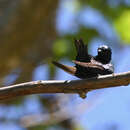en
names in breadcrumbs


A large (7 ¼ -8 ½ inches) swallow, the male Purple Martin is most easily identified by its large size, dark purple-black body, and notched tail. Female Purple Martins are purplish gray above and pale below with streaking on the breast. While the male is unmistakable in North America, the female resembles other pale breasted swallows, although it is generally much larger. On migration and during the winter, both sexes may be confused with other species of martin occurring in the American tropics. The Purple Martin breeds across much of the eastern United States and southern Canada. Other populations breed on the Pacific coast from California to British Columbia, in the interior west, and in western Mexico. This species is a long-distance migrant, wintering primarily in Bolivia and southern Brazil. Purple Martins historically bred along forest edges near water, nesting in old woodpecker holes in dead trees. Today, almost all Purple Martins, particularly those breeding in the east, nest in man-made nest boxes in urban or suburban areas. In winter, this species is found foraging over open savannah and fields, roosting in trees or buildings nearby. Purple Martins exclusively eat flying insects. In the Purple Martin’s breeding range, the easiest way to find this species is to look for the large, white, pole-mounted nest boxes in which Purple Martins prefer to nest. While foraging, this species may be seen swooping over ponds, lakes, and open country while catching insects in flight. Purple Martins are primarily active during the day.